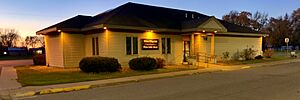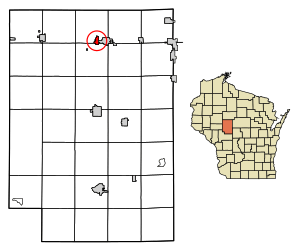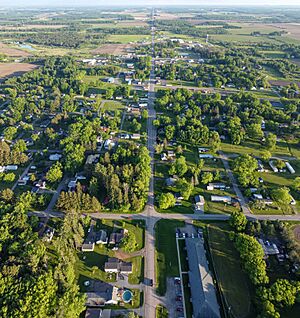Withee, Wisconsin facts for kids
Quick facts for kids
Withee, Wisconsin
|
|
|---|---|

Withee Village Hall
|
|

Location of Withee in Clark County, Wisconsin.
|
|
| Country | |
| State | |
| County | Clark |
| Area | |
| • Total | 0.83 sq mi (2.16 km2) |
| • Land | 0.83 sq mi (2.16 km2) |
| • Water | 0.00 sq mi (0.00 km2) |
| Elevation | 1,247 ft (380 m) |
| Population
(2010)
|
|
| • Total | 487 |
| • Estimate
(2019)
|
476 |
| • Density | 572.12/sq mi (220.81/km2) |
| Time zone | UTC-6 (Central (CST)) |
| • Summer (DST) | UTC-5 (CDT) |
| Area code(s) | 715 & 534 |
| FIPS code | 55-88300 |
| GNIS feature ID | 1576921 |
Withee is a small village located in Clark County, Wisconsin, in the United States. In 2010, about 487 people lived there. The village is mostly within the Town of Hixon. A small part of it also extends south into the Town of Longwood.
Contents
History of Withee
Early Settlers and the Railroad
The first person to settle in Withee was James S. Boardman, who arrived in 1870. George Richards and David R. Goodwin came soon after him. In 1874, a post office called Winneoka opened at Bernard Brown's farm. Before this, mail and supplies had to be brought from far-off towns like Greenwood and Chippewa Falls.
A big change happened in 1880 when the Wisconsin Central Railroad built a train line through Withee. This line connected Abbotsford to Chippewa Falls. The village of Withee was officially planned the next year. It was named after Niran Withee, who was a teacher and a lumberman.
Growth and Community Life
The railroad helped Withee grow very quickly. In 1881, E.A. Eaton built the first store. Soon, more businesses opened, like another general store, a grocery, a hotel, and a blacksmith shop. The first one-room school was built in 1883. By 1890, a stagecoach line connected Withee to other towns, making travel easier.
In 1893, a group of Danish Lutheran families moved to the area north of Withee. They wanted to create a Danish community and church. More Danes joined them, and by 1896, their church had thirty families. They spoke Danish and even had classes for Danish folk-dancing. Over time, the Danish community became part of the larger English-speaking area, but their church, Nazareth Lutheran, is still there today.
Modern Utilities and Development
Withee officially became a village in 1901. It was an important shipping point for lumber mills. In 1902, electricity came to the village. However, most people living outside the village did not get electricity until around 1937. This happened when the Clark Electric Cooperative put up electric lines with help from a government program called the New Deal Rural Electrification Administration.
A water system was put in place in 1907, and a volunteer fire department started in 1908. By 1906, the village had a train depot, a post office, and several churches. It also had a school and the State Bank of Withee.
Today, Withee is mostly a farming community. It is located very close to the town of Owen. Even though Withee and Owen are separate towns, they work together like one big community. They even share the same elementary and high school district, called the Owen-Withee school district.
Geography of Withee
Withee is located at 44°57′18″N 90°35′56″W / 44.95500°N 90.59889°W. The United States Census Bureau says that the village covers a total area of about 0.83 square miles (2.16 square kilometers). All of this area is land.
Population Data
| Historical population | |||
|---|---|---|---|
| Census | Pop. | %± | |
| 1910 | 443 | — | |
| 1920 | 380 | −14.2% | |
| 1930 | 380 | 0.0% | |
| 1940 | 329 | −13.4% | |
| 1950 | 421 | 28.0% | |
| 1960 | 442 | 5.0% | |
| 1970 | 480 | 8.6% | |
| 1980 | 509 | 6.0% | |
| 1990 | 503 | −1.2% | |
| 2000 | 508 | 1.0% | |
| 2010 | 487 | −4.1% | |
| 2019 (est.) | 476 | −2.3% | |
| U.S. Decennial Census | |||
What the 2010 Census Showed
In 2010, the census counted 487 people living in Withee. There were 232 households and 131 families. The village had about 586.7 people per square mile (220.81 people per square kilometer).
Most of the people in Withee were White (99.0%). A small number were Native American or Asian. About 2.3% of the population was Hispanic or Latino.
About 23.3% of households had children under 18. Many households (41.8%) were married couples living together. About 37.1% of all households were made up of individuals living alone.
The average age of people in the village was 45.5 years old. About 21.1% of residents were under 18. And 19.5% were 65 years old or older. The population was almost evenly split between males (49.3%) and females (50.7%).
Famous People from Withee
- Bruce F. Beilfuss was a very important judge. He served as the Chief Justice of the Wisconsin Supreme Court.
See also
 In Spanish: Withee (Wisconsin) para niños
In Spanish: Withee (Wisconsin) para niños


